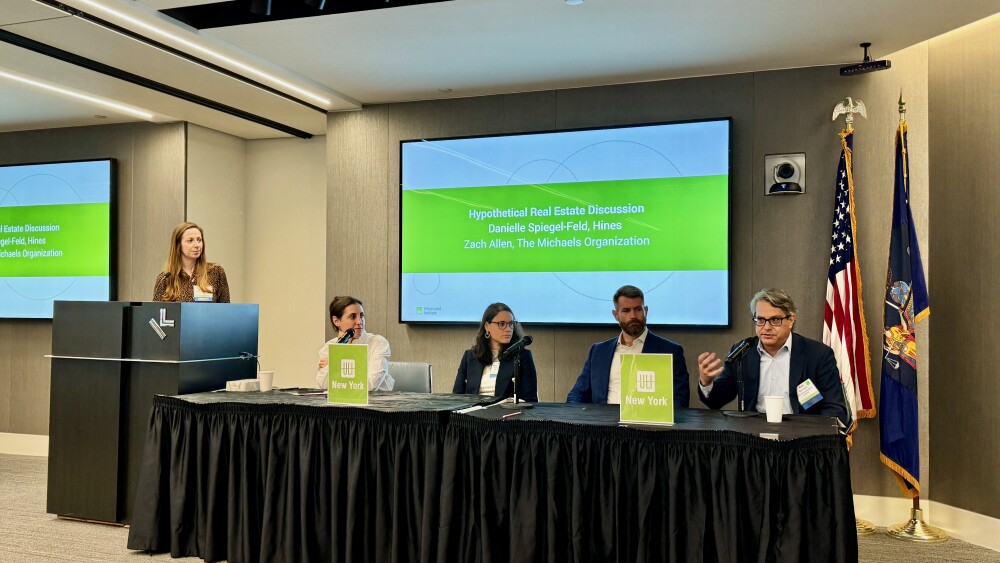
A panel on Inflation Reduction Act, New York City Sep. 26 during New York Climate Week moderated by Marta Schantz, co-executive director of the Randall Lewis Center for Sustainability in Real Estate at ULI with panelists Danielle Spiegel-Feld, director of environmental strategy at Hines; Molly Dee Ramasamy, director of the deep carbon reduction Group at Jaros, Baum & Bolles, an MEP engineering firm; Zach Allen, vice president of investment management at the Michaels Organization; and Ben Evans, federal legislative director at the U.S. Green Building Council (USGBC).
Holly Dutton
When the Inflation Reduction Act (IRA) was signed into law a little more than two years ago, it was celebrated by many who work in the real estate industry as a crucial tool for encouraging and offsetting the cost of green buildings. The tax incentives offer a lot of opportunities for owners and developers to cut expenditures, sometimes significantly, in a time when interest rates and the cost of construction remain high. Navigating the various incentives and programs has broadly proved challenging, however, and experts hope to spark more awareness around the benefits of the IRA and how to move past common obstacles.
During New York Climate Week, the IRA and its implications for the real estate sector were the topics of a September 26 panel discussion in the city. Marta Schantz—co-executive director of the Randall Lewis Center for Sustainability in Real Estate at ULI—moderated the panel. The panel consisted of Ben Evans, federal legislative director at the U.S. Green Building Council (USGBC); Molly Dee Ramasamy, director of the Deep Carbon Reduction Group at Jaros, Baum & Bolles, an MEP engineering firm; Danielle Spiegel-Feld, director of environmental strategy at Hines; and Zach Allen, vice president of Investment Management at the Michaels Organization.
Historic climate investment
Passed in August 2022, the IRA could cost $800 billion over the course of a decade, according to a Credit Suisse analysis, with the aim of reducing greenhouse gas emissions by 40 percent by 2030, versus a 2005 baseline. The IRA represents the largest climate investment in U.S. history, and the estimated cost could balloon even further, as the full extent of the act’s impact is not yet known. An estimate from Goldman Sachs suggested that its cost could rise to $1.2 trillion.
“It’s almost entirely a package of carrots,” Evans said of the USGBC. “About two-thirds of the tax incentives are to encourage folks to go out and do these things; it depends entirely on who will go out and take advantage of it.”
Although those opportunities look promising for the real estate industry, many challenges and uncertainties still surround the IRA. Evans, who lobbied for provisions in the bill, admitted that it is not perfect and that USGBC did not get everything his organization had wanted into the bill.
The IRA encompasses four primary tax incentives for real estate. One, known as 45L, is aimed at encouraging multifamily developers and homebuilders to erect energy-efficient homes. Another is 179D, a tax deduction for commercial building owners who install building systems that increase energy efficiency by at least 25 percent. Section 48 provides an energy tax credit for owners who invest in such renewable energy upgrades as rooftop solar and geothermal.
Last is the Alternative Fuel Vehicle Refueling Property Credit, an incentive for owners who install electric vehicle charging infrastructure at their properties. Note that, with all of these incentives, the beneficiary receives them after filing a tax return and once compliance with the rules of the incentives has been demonstrated to the IRS.
Opportunities and challenges
One thing all the panelists agreed upon was that many people in the real estate industry were unaware of the ins and outs of the incentives offered by the IRA. The four of them sought to make clear where the best opportunities lay and where challenges remain to surmount. Perhaps the most important aspect of the bill to know is that participants can take advantage of multiple IRA tax credits simultaneously.
For the clients they work with, Dee-Ramaswamy’s firm focuses on two tax programs: 179D and the Clean Energy Investment Tax Credit. A building can fully or partially qualify, depending on the scope of the project. Partially qualified buildings have specific reduction requirements based on system type, and energy modeling is required for new building analysis but not required for existing buildings.
For people looking to earn a tax credit, one sticking point is whether they will actually get it. Making the big commitment to install a green system but not knowing for sure whether a deduction will be rewarded after a year in operation can cause a lot of stress for owners, Dee-Ramaswamy said—something that underscores the importance of energy modeling. “The reason energy modeling can be valuable here is, if you do it the right way and it’s robust enough, you can quell some of the insecurity associated with the performance of a system, but [such energy modeling] really does need to be robust,” she said.
At Hines, which is targeting net zero operations by 2040 without using offsets, Spiegel-Feld finds that the IRA tax incentives pencil out the most in a small number of large-scale projects. “The number of transaction costs involved with monetizing these credits—especially when you are in a REIT [real estate investment trust] structure, which [applies to many of our properties]—are significant enough that you’re not going to go for it unless there’s a big enough payout,” she said, admitting that projects which meet that threshold in real estate are “fewer and farther between.”
Subsidies are part of the business model at the Michaels Organization, a longtime leader in affordable housing development. Allen said his company has found it challenging to connect the dots in monetizing and taking advantage of IRA tax incentives, though, because they get in the way of other subsidies.
For example, with certain rural deals, the company cannot collect more than a certain amount of subsidies annually. The Michaels Organization is finding success in military housing, where the prevailing wage is required and it’s “a lot easier” to use the 45L tax credit in places where the company is already achieving policy requirements.
Evans, who said he was excited to see how the IRA will help real estate during the next decade, especially given the high costs and elevated interest rates the industry is experiencing, recognized that the bill was not a silver bullet for helping finance sustainable development. “The IRA is not a panacea,” Evans said. “It doesn’t make this stuff easy, but it does make this stuff easier.”





